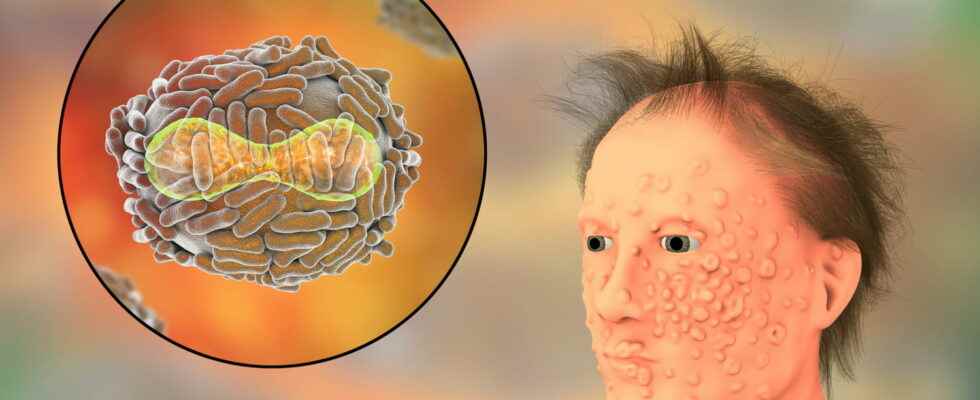Smallpox is a highly contagious viral disease officially eradicated in 1980 through vaccination. Cases of monkey pox are however reported in Europe – especially in France – in May 2022. Symptoms, mortality, vaccine, treatment… Explanations with Pr Christian Rabaud, infectiologist at the Nancy CHRU.
[Mise à jour le 20 mai 2022 à 11h00] Smallpox has claimed millions of lives worldwide. All continents have been affected. On May 8, 1980, the Member States of the World Health Organization (WHO) have confirmed its eradication from around the world. In May 2022, cases of monkey pox are reported in some European countries, including France, as well as in the United States and England. Monkey pox or “Monkeypox” is caused by a poxvirus different from smallpox virus and its ability to spread between humans is limited, recalls the WHO.
Smallpox, also called “smallpox”is a infectious and contagious pathology, due to a virus of the poxvirus family. This virus is formidable because it is very resistant, but a single infection provides lifelong immunity. Its origin remains unknown, but according to some scientists, the virus could have appeared in the Neolithic period, and would have been transmitted to humans by animals. No more cases of smallpox have been identified since the end of the 1970s (the last would have been in 1977 in Somalia). The disease has been eradicated through the effective use of international vaccination campaigns. In the 18th century, smallpox was very active in France. According to Earth Policy Institute statistics, at that time, it killed one in ten children in France. In the 20th century alone, the virus caused between 300 and 500 million deaths worldwide. No effective treatment has ever been developed. Smallpox is transmitted by inhaling droplets, following a sneeze or a cough, or by contact with items soiled with the virus.
On December 9, 1979, a worldwide commission certified that smallpox had been eradicated and this certification was officially accepted by the Thirty-third World Health Assembly on 8 May 1980.
Symptoms of smallpox usually appear two weeks after infection and include high fever around 40°C, headaches, body aches, nausea and vomiting. The rash of smallpox is characteristic: it initially presents as a pustules (lesions resembling small glass balls that fill with liquid under the skin) which will become ulcerated and crusted, and then give way to scars.
Unlike chickenpox, which evolves into several flare-ups, in smallpox, the rash is all in one piece.
Unlike the varicella which develops into several outbreaks, in smallpox, the eruption occurs all at once, and the lesions which will be observed are all the same age. “What made smallpox so serious at the time was that these lesions became superinfected with bacteria, especially staph, and we would die of sepsis infection“, comments Professor Christian Rabaud.
Smallpox is caused by a virus from the poxvirus family, known to be responsible for skin manifestations. The origin of the appearance of smallpox is unknown but it could be linked to the transmission of one of the animal poxviruses which has gradually adapted to humans.
Smallpox has been around for at least 3,000 years and has affected every continent. We do not know the exact number of deaths through the decades but according to the WHO, it caused the death of 300 to 500 million people in the 20th century alone. It is said to have killed 200,000 people in France between 1870 and 1871. To date, the disease has been eradicated, so it no longer kills people.
The diagnosis of smallpox is both clinical by observing characteristic lesions, and virological by analyzing them. “Today, smallpox cannot reappear on its own, except in the context of bioterrorism because it is known that certain strains have been kept by American and Russian laboratories. Knowing that people born after 1975 have never been vaccinated against smallpox, if the disease reappeared today, it would be like the appearance of covid-19, namely on a population that has no antibodies, no defense, which would be conducive to the development and spread of smallpox”, details the infectiologist.
There is no cure for smallpox but only vaccines. “Some antivirals might be effective against smallpox, but they have never been tested in a human setting since there have been no cases since the late 1970s.reacts the infectiologist. What is certain is that, if it reappeared, smallpox would be much less serious since we have the means to avoid bacterial superinfection of this viral infection. Lung infection would also be better managed with conventional resuscitation measures (intubation, oxygenation)”. Isolation of patients is also essential.
It exists a smallpox vaccine, which eradicated the disease. It was developed by English physician Edward Jenner. Smallpox was the first vaccination in human history, long before Pasteur. The first vaccinations in France took place in 1799 (150,000 in 1806 to 750,000 in 1812). The annual number of smallpox deaths fell from 50,000-80,000 cases to about 2000. Countries where vaccination was used saw smallpox mortality fall from 10% to 1% in a few years.
Source: Commemoration of the eradication of smallpox – a legacy of hope for COVID-19 and other diseases, WHO, May 8, 2020 / CHU de Montpellier “La variole”.
Thank you to Pr Christian Rabaud, infectiologist, Head of the Infectious and Tropical Diseases Department of the University Hospital of Nancy.
